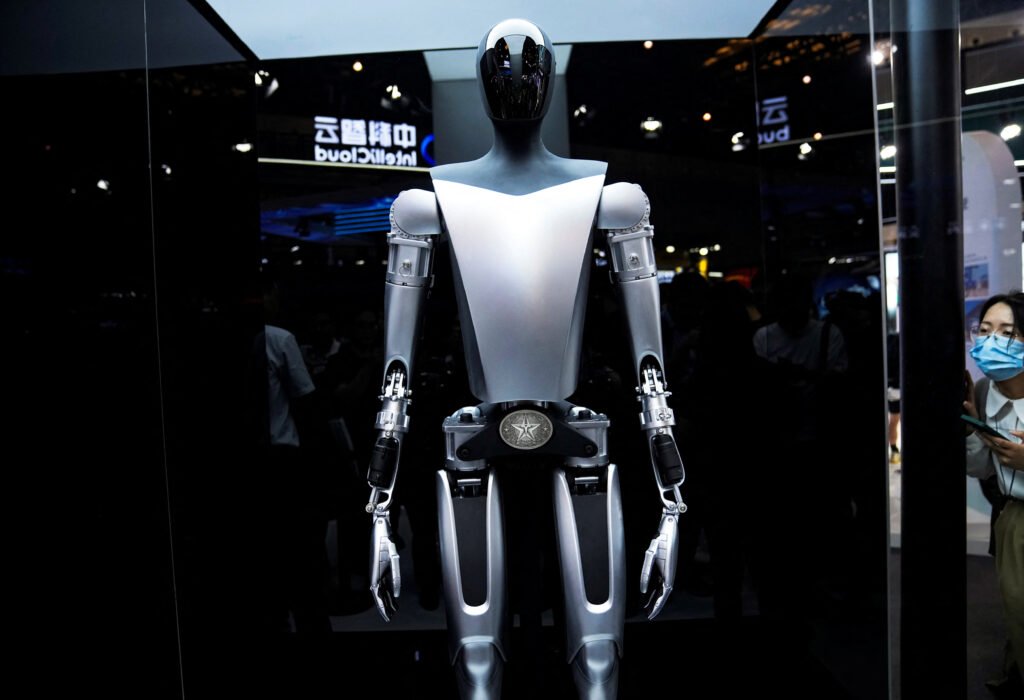Discover how Artificial Intelligence revolutionizes Cybersecurity, bolstering Threat Detection for a more secure digital landscape.
KEY TAKEAWAYS
- Improved Threat Detection: AI significantly enhances cybersecurity by swiftly identifying and responding to cyber threats using advanced techniques like machine learning and natural language processing.
- Efficiency Through Automation: AI’s automation capabilities streamline cybersecurity operations, enabling faster responses and greater scalability while reducing the burden on human analysts.
- Future-Ready Security: AI-driven cybersecurity is adaptable and well-prepared for future challenges, offering the potential to transform security measures in a rapidly evolving digital environment.
In an increasingly interconnected world, the relentless march of technology has opened up new frontiers, but it has also paved the way for a stealthier breed of adversaries – cybercriminals. In this digital battleground, where the stakes are higher than ever, emerges a formidable ally: Artificial Intelligence (AI). Welcome to the transformative landscape of “The Use of AI in Cybersecurity.”
Picture a world where an intelligent sentinel stands guard over your digital life, tirelessly scanning the vast expanse of data, sifting through endless codes and signals, and instantly identifying threats. This sentinel is the embodiment of AI, revolutionizing the field of cybersecurity. Its power lies in its ability to not just detect known threats but to predict and adapt to the ever-evolving tactics of malicious actors.
This article delves deep into the synergy between Artificial Intelligence, Cybersecurity, and Threat Detection. The article will also uncover how AI is reshaping your digital defenses, arming us with proactive tools to combat an array of cyber threats. Join us on this journey through the cutting-edge world of AI-powered cybersecurity, where innovation meets protection in the battle for our digital future.
The Evolution of Cyber Threats
In the ever-expanding digital landscape, the battleground for cybersecurity has evolved into a complex and dynamic arena. Understanding the evolution of cyber threats is crucial in appreciating the role that Artificial Intelligence (AI) plays in fortifying your digital defenses. This section will delve into the nuances of modern cyber threats and the growing sophistication of threat actors.
Understanding Modern Cyber Threats
Cyber threats have come a long way from the early days of simple viruses and basic hacking attempts. Today, they encompass a diverse array of attacks that constantly challenge your cybersecurity measures. Explore some of the most prevalent types of cyberattacks and how AI is instrumental in identifying and mitigating them.
Types of Cyberattacks (e.g., malware, phishing, DDoS)
- Malware: Malicious software, or malware, includes viruses, worms, Trojans, and ransomware. AI’s role in cybersecurity shines in its ability to detect the subtle signatures and behaviors of these threats, even when they mutate to evade traditional defenses.
- Phishing: Phishing attacks rely on social engineering to deceive individuals into revealing sensitive information. AI-driven email filters and pattern recognition are effective tools in recognizing and thwarting phishing attempts.
- DDoS (Distributed Denial of Service): DDoS attacks flood a network or website with overwhelming traffic, causing service disruptions. AI-powered systems can quickly identify abnormal traffic patterns and implement countermeasures to maintain online service availability.
The Growing Sophistication of Threat Actors
As technology advances, so do the capabilities of threat actors. Cybercriminals, hacktivists, and state-sponsored groups are becoming increasingly sophisticated in their tactics. AI in cybersecurity is not only about keeping pace but also about staying one step ahead.
The utilization of AI by threat actors is a concerning trend. They leverage AI-driven tools to automate attacks, target vulnerabilities more effectively, and evade traditional security measures. This arms race between cybersecurity professionals and threat actors has led to the development of AI-driven defense systems that can adapt in real time to emerging threats.
In the face of these evolving challenges, AI has emerged as a critical ally. Its ability to analyze vast datasets, recognize anomalies, and predict potential threats is instrumental in maintaining the integrity of your digital world. As you navigate the intricate realm of cybersecurity, understanding the landscape of modern cyber threats and their AI-driven countermeasures is paramount.

Photo: Reuters
The Role of Artificial Intelligence
As you venture deeper into the digital age, the role of Artificial Intelligence (AI) in cybersecurity has become increasingly pivotal. This section unravels the multifaceted contributions of AI to the realm of cybersecurity, highlighting how it is revolutionizing the way you protect your digital assets.
How AI is Revolutionizing Cybersecurity
AI’s impact on cybersecurity is nothing short of transformative. Its applications span a wide spectrum, from enhancing threat detection to automating response mechanisms. Learn these key facets of AI’s role in revolutionizing cybersecurity.
Machine Learning in Threat Detection
Machine learning is at the forefront of AI’s contributions to cybersecurity. This technology empowers systems to learn from vast datasets, recognize patterns, and make informed decisions. In the context of threat detection, machine learning algorithms excel at discerning normal network behavior from anomalous activity. This capability enables the identification of potential cyber threats in real time, even when they exhibit novel tactics or disguises.
Natural Language Processing for Anomaly Detection
Natural Language Processing (NLP) is another powerful AI tool that finds its place in cybersecurity. NLP algorithms are proficient in understanding human language, making them invaluable for analyzing textual data, such as emails and chat logs. In anomaly detection, NLP can be employed to scrutinize written communication for signs of phishing attempts, data breaches, or insider threats. By deciphering the context and sentiment of messages, NLP aids in pinpointing suspicious activities that might elude traditional keyword-based filters.
Automation and Response with AI
AI’s capabilities extend beyond mere detection; it encompasses automation and response as well. In the fast-paced world of cybersecurity, swift action is often the difference between a minor incident and a catastrophic breach. AI-driven systems can automatically respond to threats by isolating compromised devices, blocking malicious traffic, and initiating incident response protocols. This not only reduces response time but also alleviates the burden on human analysts, allowing them to focus on more complex aspects of cyber defense.
In essence, AI is revolutionizing cybersecurity by infusing it with intelligence, adaptability, and efficiency. Its machine learning algorithms, natural language processing, and automation capabilities collectively strengthen your ability to safeguard digital assets in an era where cyber threats continue to evolve. This dynamic fusion of technology and security is at the forefront of the ongoing battle to protect your interconnected world.
Benefits of AI in Cybersecurity
The integration of Artificial Intelligence (AI) into the field of cybersecurity has ushered in a new era of digital defense. This section will explore the myriad benefits and profound impacts that AI brings to the world of cybersecurity, focusing on enhanced threat detection and prevention, real-time incident response, scalability, and adaptability.
Advantages and Impacts
AI’s presence in cybersecurity goes beyond mere buzzwords; it translates into tangible advantages that strengthen your defenses against cyber threats. Some of its advantages include;
Enhanced Threat Detection and Prevention
One of the standout benefits of AI in cybersecurity is its prowess in enhanced threat detection and prevention. Traditional security systems often rely on known threat signatures, leaving them vulnerable to emerging and sophisticated attacks. AI, powered by machine learning, excels at identifying anomalies within vast datasets. It discerns even subtle deviations from normal network behavior, enabling early detection of threats. This proactive approach is a game-changer, thwarting attacks before they can cause significant harm.
Real-time Incident Response
The speed at which cyber threats evolve demands equally rapid responses. AI’s contribution to real-time incident response is invaluable. When a potential threat is detected, AI-driven systems can initiate immediate actions. They can isolate compromised devices, shut down malicious processes, and contain the threat, all in the blink of an eye. This agility significantly reduces the impact of cyber incidents and minimizes downtime, crucial in today’s interconnected world.
Scalability and Adaptability
AI-driven cybersecurity solutions possess a remarkable degree of scalability and adaptability. Whether you’re a small business or a global enterprise, AI systems can flexibly adjust to your needs. As your organization grows, AI can seamlessly scale its operations to accommodate increased network traffic and data volume. Moreover, AI continuously learns and adapts, evolving alongside emerging cyber threats. This adaptability ensures that your defenses remain effective against the ever-evolving tactics of cybercriminals.
overall, the benefits of AI in cybersecurity are transformative. Enhanced threat detection and prevention, real-time incident response, scalability, and adaptability are all pivotal in ensuring a robust and dynamic defense against the relentless onslaught of cyber threats. As you embrace the capabilities of AI, you empower yourself to proactively protect your digital assets and navigate the evolving landscape of cybersecurity with confidence.

Photo: Toby Sterling
Challenges and Limitations
While the integration of Artificial Intelligence (AI) in cybersecurity offers tremendous advantages, it also comes with a set of challenges and limitations. This section explores various considerations associated with AI in cybersecurity, including concerns related to data privacy and ethics, the issue of false positives and negatives, and the challenges stemming from skill gaps and implementation complexities.
Considerations of AI in Cybersecurity
Implementing AI in the realm of cybersecurity requires a careful examination of several critical considerations. Delve into these aspects:
Data Privacy and Ethical Concerns
The use of AI in cybersecurity often involves the analysis of vast amounts of data, including personal and sensitive information. This raises data privacy and ethical concerns. Protecting individuals’ privacy while leveraging AI’s analytical capabilities is a delicate balance. Striking the right equilibrium between security and privacy is a challenge that cybersecurity professionals must navigate with care. Additionally, ethical considerations around AI decision-making and potential biases in AI algorithms must be addressed to ensure fairness and transparency.
False Positives and Negatives
AI-powered threat detection systems, while highly effective, are not immune to false positives and negatives. False positives occur when the system incorrectly identifies benign activities as threats, potentially inundating cybersecurity teams with unnecessary alerts. Conversely, false negatives are instances where genuine threats slip past AI defenses unnoticed. Striking a balance between minimizing false alarms and ensuring thorough threat coverage is a persistent challenge in AI cybersecurity.
Skill Gap and Implementation Challenges
The successful deployment of AI in cybersecurity requires specialized knowledge and skills. There is often a skill gap in organizations, as not all cybersecurity professionals possess the expertise to effectively manage AI-driven systems. Acquiring and retaining AI talent can be challenging. Furthermore, implementation challenges, such as integrating AI into existing security infrastructure and ensuring compatibility, can be complex undertakings that demand careful planning and execution.
overall, while AI holds immense promise in bolstering cybersecurity, it’s essential to acknowledge and address the challenges and limitations that accompany its adoption. From navigating data privacy and ethical concerns to fine-tuning threat detection systems to minimize false positives and negatives, and finally, bridging skill gaps and overcoming implementation complexities—these considerations are pivotal in realizing the full potential of AI in safeguarding your digital world.
Case Studies
To truly grasp the tangible impact of Artificial Intelligence (AI) in the realm of cybersecurity, some real-world examples are explored where AI has been harnessed to enhance digital defenses. These case studies shed light on the practical applications and successes of AI-driven security solutions.
Real-world Examples of AI in Action
Case 1:IBM Corporation’s AI-driven Security
IBM Corporation, a global leader in technology solutions, faced an escalating battle against sophisticated cyber threats. To fortify their defenses, they turned to AI-driven security.
Implementation: IBM Corporation integrated AI-powered threat detection systems into their network infrastructure, bolstering their ability to monitor, analyze, and respond to potential threats in real time.
Impact: The results were impressive. AI’s machine learning algorithms quickly adapted to the evolving threat landscape. They identified subtle anomalies, even zero-day attacks, with remarkable accuracy. False positives were significantly reduced, allowing the security team to focus on genuine threats. The system’s automation capabilities enabled rapid incident response, preventing data breaches and minimizing downtime.
Case 2: Government Agency “The Department of Homeland Security (DHS).”Successful Integration
The Department of Homeland Security (DHS).” This agency is responsible for safeguarding the United States against various threats, including cybersecurity threats, and it has been actively involved in enhancing its cybersecurity defenses using AI and other advanced technologies.
Implementation: Government Agency, The Department of Homeland Security (DHS). implemented AI-driven cybersecurity solutions across its critical systems. These solutions utilized Natural Language Processing (NLP) to analyze vast amounts of textual data for signs of cyber threats.
Impact: The results were transformative. NLP-based AI systems combed through enormous volumes of data, such as emails and reports, identifying potential security risks and anomalies in real time. This proactive approach enabled the agency to thwart several cyberattacks, preserving the integrity of vital infrastructure.
These case studies vividly illustrate the power of AI in enhancing cybersecurity. Organizations like IBM Corporation and Government Agency DHS have harnessed AI’s capabilities to protect their digital assets, mitigate threats, and respond swiftly to emerging challenges. These real-world successes underscore the critical role that AI plays in the ongoing battle to secure your interconnected world.
Future Trends and Developments
As the digital landscape continues to evolve at an unprecedented pace, the future of cybersecurity relies heavily on the continued integration of Artificial Intelligence (AI). This section will explore the exciting developments and trends that lie ahead in the realm of AI-driven cybersecurity.

Photo: Aly Song
The Road Ahead for AI in Cybersecurity
The journey of AI in cybersecurity is far from complete; in fact, it is just beginning. The road ahead promises a plethora of innovations and advancements that will redefine how you defend against cyber threats. Delve into some of these future trends and developments.
AI-Powered Autonomous Security Systems
The concept of AI-powered autonomous security systems represents a significant leap forward. Imagine security systems that not only detect and respond to threats but can make real-time decisions to counteract them without human intervention. These systems, equipped with advanced AI, will continuously learn from their environment and adapt to emerging threats, providing an unprecedented level of protection.
AI in IoT Security
With the proliferation of Internet of Things (IoT) devices, the attack surface for cyber threats has expanded exponentially. In the future, AI will play a pivotal role in securing IoT ecosystems. AI algorithms will monitor and analyze the behavior of interconnected devices, identifying and mitigating potential vulnerabilities and threats. This will be crucial in ensuring the security and privacy of your increasingly interconnected world.
The Role of Quantum Computing
The advent of quantum computing introduces both challenges and opportunities in cybersecurity. Quantum computers have the potential to break many encryption methods currently in use. However, they also offer new encryption techniques that can be virtually unbreakable. AI will be instrumental in adapting cybersecurity to the quantum era, ensuring that your data remains secure in this new computing paradigm.
overall, the future of AI in cybersecurity holds tremendous promise. AI-powered autonomous security systems, IoT security enhancements, and the adaptation of cybersecurity to quantum computing are just a few of the exciting developments on the horizon. As technology continues to advance, AI will remain at the forefront of your defense against ever-evolving cyber threats, shaping the future of cybersecurity in a digital world.
Final Thoughts
The symbiotic relationship between Artificial Intelligence (AI) and Cybersecurity has emerged as the ultimate bulwark against an onslaught of ever-more-sophisticated threats. AI, with its machine learning prowess, has revolutionized how you protect your digital assets. It empowers you to detect threats swiftly, respond in real-time, and adapt to the constantly shifting threat landscape.
As you’ve journeyed through this exploration of AI in Cybersecurity, you’ve witnessed its incredible power in enhancing threat detection, automating incident response, and fortifying your defenses. You’ve also delved into the challenges of data privacy, false alarms, and skill gaps, which remind us that AI’s integration requires meticulous care and ethical considerations.
Looking forward, the road ahead for AI in Cybersecurity is brimming with promise. From autonomous security systems to safeguarding the Internet of Things, and even the quantum era of computing, AI stands as your sentinel, ready to defend and innovate in the name of digital security.
As technology advances, so does your capacity to protect, and in this digital frontier, Artificial Intelligence is our greatest ally in the relentless quest to secure your digital future.











































